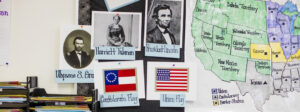Schools have already faced unprecedented challenges during the COVID-19 outbreak, from shifting to distance learning on the fly to providing essential services like meals during extended closures. But the decision by a growing number of states to keep schools closed for the rest of the academic year raises a new set of questions for leaders and policymakers.
Chief among them: how can teachers earn the certification they need to enter or stay in the classroom when it’s impossible to take the required certification tests? Most states require teachers to pass several standardized tests to earn their license, but testing centers have been ordered closed almost everywhere.
It’s an urgent challenge because school systems will need to fill hundreds of thousands of open teaching positions between now and the start of the new school year, even if attrition dips slightly due to the economic downturn. Schools are counting on a steady supply of new teachers to fill many of those vacancies. Without it, many will face a teacher shortage heading into a year when students will need great teachers more than ever.
Big testing companies are scrambling to develop workarounds. ETS, which administers the widely-used Praxis certification test, recently launched an “at-home” version of the test with a virtual proctor. That carries with it its own set of likely problems, from inconsistent access to broadband internet to security issues to technical bugs.
Luckily, there’s a solution that’s cheaper, simpler, and better: stop relying solely on standardized tests, and start focusing certification rules on actual teaching ability.
You may think Praxis and other tests already paint a reliable picture of classroom effectiveness, but that’s a myth. Most research has found that standardized tests are weak predictors of a teacher’s ability to help students learn—and we see that all the time in our own teacher training programs. Every year, we see teachers with a proven ability to lead their kids to big academic gains (as reflected in test scores, classroom observations, and other measures) face the prospect of losing their jobs because of their Praxis scores. We also see plenty of teachers who pass standardized licensure tests but struggle in the classroom. In short, passing certification exams is far from a guarantee of effectiveness, and failing is far from a guarantee of ineffectiveness.
To make matters worse, standardized licensure tests block a disproportionate number of teachers of color from entering the classroom. ETS itself reports that pass rates for the Praxis are 20 percent lower among Latinx test takers and 40 percent lower among Black test takers compared to whites. And tests are expensive, often costing prospective teachers more than a hundred dollars per attempt. It’s a significant financial barrier to the profession—one that we should be especially conscious of during a severe economic downturn.
In other words, replacing or supplementing standardized certification exams with other criteria would likely help diversify the teacher workforce without diminishing its quality. In fact, adopting a process more directly tied to performance in the classroom as a student teacher, intern, or novice would substantially raise the bar for certification. We’ve used this approach to certify tens of thousands of teachers in our programs for nearly a decade.
States should use this disruption in certification testing as an opportunity to work toward this better approach—one that meets the needs of schools and prospective teachers this year, and helps create a more meaningful bar for certification for the long run. That means taking three steps this year:
- Provide flexibility around testing requirements for teacher certification for at least one year. No teacher should be barred from the classroom just because they couldn’t safely take a certification test. Twenty-two states have already delayed or waived testing requirements for this coming year, and those who haven’t should take that step immediately.
- Create alternate requirements tied to evidence of classroom performance. States should allow evidence of effectiveness in the classroom to substitute for scores on licensure tests. These measures don’t have to include or be limited to standardized test scores: classroom observations, assessments of student work, and student surveys—some or all of which are part of many districts’ teacher evaluation systems—can provide valuable information as well. States should waive any testing requirements for teachers who meet these alternate requirements.
- Evaluate the results. Since states will have to grant exceptions to testing requirements this year, they should take the opportunity to gather evidence on how current test-based rules compare to a performance-based alternative—focusing on effectiveness, retention, and diversity of teachers certified under different criteria. And if performance-based certification proves to be a better or even as good as standardized tests at predicting future classroom effectiveness, states should make their alternative certification pathways permanent and consider eliminating testing requirements entirely.
Restarting our schools this fall will be one of the greatest challenges our education system has ever faced. It will require extraordinary efforts at all levels, from government officials down to teachers and families. We should focus our efforts on what we know matters most—connecting great educators with students and giving them the support they need to be successful—instead of retrofitting outdated certification requirements. With this foundation in place, our public education system will be better prepared for what lies ahead.





